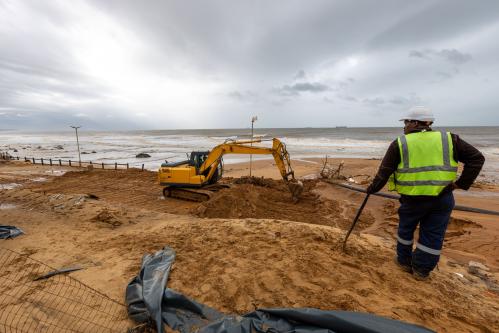Introduction
Over the last two years, India has signed bilateral nuclear power agreements with several countries, including the U.S., France, Russia, Kazakhstan and Canada. On July 30, a prerequisite for U.S. nuclear fuel suppliers to conduct business with India was concluded with the two countries signing an agreement on the reprocessing of American nuclear spent fuel by India, marking the final steps toward implementation of the landmark 2008 civil nuclear deal. These latest arrangements and procedures will enable reprocessing by India of the U.S.-obligated nuclear material at a new national reprocessing facility to be established by India and dedicated to the reprocessing of safeguarded nuclear material under International Atomic Energy Agency (IAEA) safeguards.
Efforts by foreign companies to enter the Indian market will not be successful in the absence of a Civil Liability for Nuclear Damage (CLND) legislation, which is necessary for investors who are unwilling to accept unquantified risks of nuclear energy without some limitation on their liability. Specifically for the U.S., progress toward two nuclear reactor park sites designated by India for U.S. technology in the states of Andhra Pradesh and Gujarat has been held up in the absence of a CLND Act. Both the U.S. and India would like to have the legislation in place prior to President Obama’s visit to India in November.
It is noteworthy that the legacy of cooperation and deals between state-controlled enterprises in Russia and India is bearing fruit. The much-delayed 1,000 MW first unit of Kudankulam nuclear generating station in Tamil Nadu, being built with Russian collaboration, will be active by December. The plant will be made operational irrespective of whether the proposed nuclear liability legislation is enacted. The second unit of the Kudankulam power plant is envisaged to come on stream within six months of commissioning the first unit by June 2011. Russia does not seem overly anxious about the passage of the liability bill before its companies conduct business in India.
Background
Given the legacy of the present energy profile, growing energy demand in emerging markets, broad availability and the evolution of prices, fossil fuels will continue to comprise a significant part of the global energy mix until 2030, even for developed blocs like Europe and the US. India will be no different (see Table 1 for India’s electricity projections by fuel). The single largest fossil fuel in the energy mix is coal at 40 percent of India’s energy consumption and is the most abundant and domestically available primary energy resource other than thorium and solar insolation.
Table 1: Generation Capacities and Load Factors, 2031/32
|
Source |
Capacity (GW) |
|
Coal |
270 |
|
Natural Gas |
70 |
|
o/w Coal bed methane |
28 |
|
In-situ Coal gas |
22 |
|
Nuclear |
63 |
|
Hydro |
150 |
|
IGCC pet coke |
3 |
|
Wind – onshore |
32 |
|
Wind – off-shore |
1 |
|
Biomass gasification |
1 |
|
Biomass combustion |
50 |
|
Solar |
10 |
|
Total |
700 |
Note: 1 GW is equal to 1,000 MW.
Source: Report of the Expert Committee on Integrated Energy Policy, 2006.
Although hydrocarbon-based power is likely to remain the mainstay for India’s power sector at a construction cost in the median range of $1.4 – 2.5 million per MW, the potential size of India’s nuclear business is huge. In two decades, India hopes to more than double the share of nuclear power in its electricity portfolio from 4.2 percent at present to 9 percent, a 14-fold increase in installed capacity to 63 GW over the next two decades.
India’s Nuclear Energy Strategy
Nuclear energy theoretically offers India long-term energy security. Achieving this goal is crucially dependent on India implementing its long-standing strategy of nuclear fuel recycle as compared to the preponderant once-through fuel cycle. This entails the realization of the multi-stage development process to tap into India’s vast thorium resource – about a quarter of known global reserves.
Continuing support to the three-stage development of India’s nuclear potential is essential. India is extracting uranium from extremely low grade ores, often as low as 0.1 percent, compared to ores with up to 12-14 percent uranium in certain geographies elsewhere; this makes Indian nuclear fuel 2-3 times costlier than international supplies. The substantial thorium reserves can be used but only if it can be converted to fissile material. In this context, a three-stage nuclear power program has underpinned India’s objectives in the sector:
- Establishing pressurised heavy water reactors (PHWRs) in the first stage – which has now reached maturity – since these reactors are efficient users of natural uranium for yielding plutonium fuel. Capacity addition supplemented by electricity generation through light water reactors (LWRs), initially through imports of technology from Russia but with the long-term objective of indigenization.
- Fast breeder reactors (FBRs) in the second stage based on plutonium yield from the first stage. The FBRs will also recycle spent uranium from PHWRs to breed more plutonium fuel for electricity generation. FBR technology is critical to developing stage two of India’s nuclear power program, otherwise it will find it difficult to go beyond 10,000 MW installed capacity based on domestic uranium resources. Deployment of FBR technology would enable indigenous uranium resources to support a much larger nuclear power program by 2020 and more importantly thorium used as blanket material in FBRs will produce uranium 233.
- The third stage deploys reactors based on the uranium 233-thorium 232 cycle. The “resource multiplier” for power generation of the three-stage strategy is summarized in Table 2.
Table 2: Approximate potential available from nuclear energy in India
|
|
Amount (tonnes) |
Electricity (MW) |
|
Uranium: |
61,000 |
|
|
in PWHR |
|
10,000 |
|
in FBR |
|
500,000 |
|
Thorium: |
225,000 |
|
|
in Breeders |
|
Very large |
Against this background, the 2008 civilian nuclear agreement with the U.S. has catalysed for India autonomy and choice along three dimensions:
- Access to secure long-term uranium supplies from abroad to close the gap between capacity factor and availability factor of existing PHWRs.
- Add PHWR capacity through imports of up to 40 GW.
- Harness external innovation in both equipment and fuel that would allow India to use its ample indigenous supply of thorium.
The Legislative Challenge
In the current monsoon session of India’s Parliament, an important piece of legislation essential for foreign investment and commerce into India’s energy sector will be discussed by the Parliamentary Standing Committee on Science and Technology and then voted upon by both houses of India’s Parliament. It is unclear whether all this will be accomplished in the month-long session, which ends on August 27. The CNLD bill – which will become an act after it is passed by Parliament – has been caught in a controversy with several opposition political parties demanding its redrafting.
Key contentious issues for resolution at the Parliamentary committee stage include: enhancing ceiling on damages – the Supreme Court’s judgement on the Bhopal gas calamity has triggered a demand for a stronger compensation regime in industrial accident cases; broadening the “actors” beyond operators of the facility who would be liable for compensation; extending the statute of limitations; and whether a separate dispensation for liability should be given to Indian nuclear energy operators, which would in effect bias the sector somewhat against foreign investment.
The current draft of the CNLD bill stipulates in clause six the maximum financial liability of the operator of a nuclear power plant at five billion rupees. If the damage is assessed to be more than this, the additional money has to be provided for by the government up to Special Drawing Rights 300 million (21 billion rupees) in congruence with the 1997 Convention on Supplementary Compensation for nuclear damage, developed under the auspices of the IAEA. This amount is felt to be inadequate in India partly because of the recent paltry damages awarded in the Union Carbide case; for example, the Price Anderson Act 1957 in the U.S. established a no fault insurance-type system in which the first $10 billion is nuclear industry-funded, and any claims above the $10 billion would be covered by the federal government.
There is the prospect that outstanding matters before the Parliamentary Committee could be resolved, albeit not exactly, along the following lines:
- A doubling of the operator compensation cap to 10 billion rupees could be recommended.
- Since the full effects of cancer caused due to exposure to radiation could take 10-15 years to be known, the Parliamentary Committee is also likely to suggest extending the period of victims claiming damages in clause eighteen of the bill from the current 10 years from the time of a nuclear incident to more than 15 years.
- From the perspective of expanding the scope, even as it is contemplated that clauses may be inserted to cover eventualities like accidents during transport of nuclear materials or in their handling at domestic and even foreign ports, it is unclear whether pressure from proponents to insert a supplier liability clause will be successful.
In conclusion, while the deadline is tight relative to the process that still has to be traversed before the CLND bill is legislated, it is possible for hard work and compromise over the next two weeks to bear fruit and further unlock business opportunities in the Indian nuclear power sector.



Commentary
Op-edCrucial Deadline for Nuclear Energy Business in India
August 17, 2010